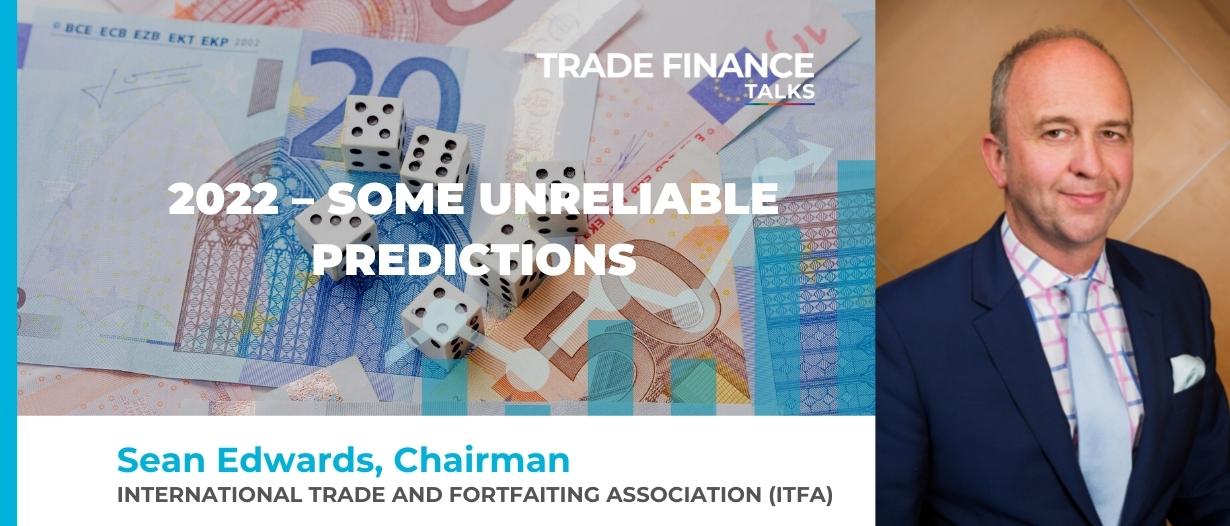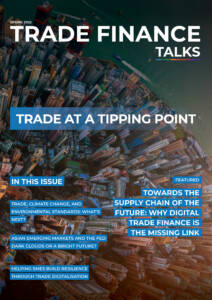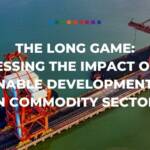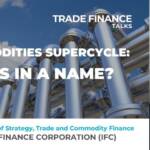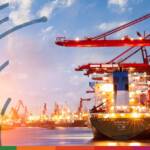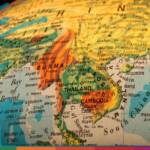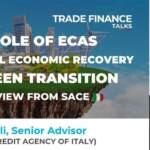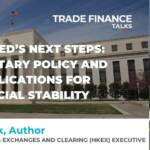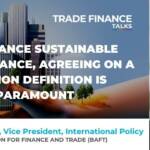Cradling the bottle of whiskey generously donated to me by the editor of this website (a personal gift, dear Compliance Department), I have been tempted into engaging in that most fateful of traditions: predicting the year ahead.
Implicit in this exercise is that the New Year will give birth to an explosive new phenomenon or, equally sensationally, explode an old one.
The problem is, however, that my crystal ball foresees steady evolution, rather than dramatic change.
With one exception. So, let’s start with that one.
Supply chain goes mainstream
When The Economist listed its top words of 2021, the phrase “supply chain” featured prominently, but unsurprisingly.
When the very foundation of Christmas starts to tremble at the prospect of no tinsel and toys, the public takes note of a process that we trade financiers have long held close to our hearts, and even claim to understand.
The most significant words of 2021 were once again covid-related https://t.co/Y4Sz2UFDMX
— The Economist (@TheEconomist) December 30, 2021
The supply chain problems the developed world experienced arose largely because of temporary, circumstantial problems – ships blocking canals, too many mariners incapacitated by COVID-19, a shortage of lorry drivers, and so on.
But what goes down must come up, and it is a safe assumption that the severity of these topical factors will ease, at least relative to where we are now.
The more difficult and more interesting question to answer is: when?
Euler Hermes, among others, has pointed to a recovery in the second half of the year.
That appears reasonable, as the main physical constraint – the pandemic – still needs to be mastered, not just medically but in terms of popular and political will to accept the virus as endemic.
At some point, the world will find a balance, but this will take some time.
We should not make the mistake, however, of confusing a physical recovery with a dramatic rebound in world trade.
The cork is being prised out of the bottle, but the genie is still anaemic for various reasons, including a weaker than expected propensity to spend, with no real boost from pent-up demand; or unspent and under-spent funds “saved” during the pandemic.
Geopolitical tensions are either surging or unresolved. Beyond the very visible events in Europe, another canker remains: the proper place of globalisation in the world economy.
The invisible hand of competitive advantage that globalisation allows to flourish on a truly massive scale will remain a strong reason for favouring free trade, and some of the reactions to this issue, such as re-shoring and 3D printing, will take time to implement, and might even be reductive in their effect on GDP.
But this is a story that will run and run.
Digital footsteps out of the pandemic
The notion that the pandemic has accelerated digitisation hypersonically is, taken literally, one of the biggest false positives of the last two years.
As I never tire of saying, using electronic signatures is not digitisation. But this does not mean that nothing has happened – far from it.
Multiple obstacles line the path to the digitisation of trade. Some are internal to those who should be its greatest champions – such as banks and financial institutions – and some are external.
But first, the good news.
The endorsement by the G7 of a fundamental cornerstone of trade digitisation – legal change in the shape of the adoption of UNCITRAL’s Model Law on Electronic Transferable Records (MLETR) – could be taken up by the incoming German presidency.
Today we have outlined to the Indian banking community how @Automaxisa aims to become the first #trade #documentation platform embracing #MLETR as per @G7 recommendations #DNI_Initiative powered by @EnigioTime and @XinFin_Official pic.twitter.com/AsUelBrDgM
— André Casterman (@AndreCasterman) December 18, 2021
Legal change is a necessary but not, in itself, sufficient catalyst for trade digitisation.
What must happen is commercial development of powerful systems and platforms.
With some outlying exceptions, the development model for digitisation at this scale has become a partnership between vendors, platform operators, and banks.
Developers do not seek to boil the ocean, and nor are banks going it alone (for the most part).
This symbiotic approach encourages efficiency and will be the pattern for trade digitisation this year.
It has yet to happen at scale, but the pioneers – and those with the greatest vested interests – are realising that they have a responsibility to fund and develop the network.
With competition taking a temporary backseat to allyship, encouraging progress is being made, but this will not happen overnight.
If 2021 was the year of the Great Resignation, then maybe 2022 will become the year of the Great Integration.
Customer demand is the other great catalyst, and there also seems to be promising movement.
What makes @Enigiotime and @XinFin_Official so relevant? Have a look at @G7 priority on electronic transferable records #MLETR to change laws and enable #digital #trade #tradefinance -> more on today’s webinar with @Automaxisa @XinfinUSA @AndreCasterman https://t.co/clEyKxaQqz
— André Casterman (@AndreCasterman) December 18, 2021
As MLETR adoption – or, in the UK, MLETR alignment – starts to become widespread, customers – including commodity traders – are realising that digitisation of ubiquitous instruments such as bills of lading, bills of exchange, and promissory notes is no longer a pipe dream, and are calling for solutions – the sweetest song of all.
ITFA, for example, has successfully worked with Abu Dhabi Global Market (ADGM) to smooth adoption in that jurisdiction, and is now working with the Dubai Financial Services Authority (DFSA) to the same end.
The noble cause of climate and finance
Will ESG save the planet, or is it just “blah, blah, blah”, as one famous climate change activist would have it?
For banks and other lenders, the reality is not about phasing down or phasing out, but phasing in.
It’s worth pondering just how significant a paradigm shift that is compared to a year ago.
All financial services firms must now have policies and processes to deal with “green finance”.
Critics should appreciate this gargantuan step, even if it has not, and could not, immediately solve climate change.
It is true that there is currently more stick than carrot, however.
Legislation has already obliged the financial services sector to embed ESG into credit decision-taking.
In the EU, for example, this comes in the form of disclosure rules like the Sustainable Finance Disclosure Regulation and the Corporate Sustainability Reporting Directive.
How does the EU’s Sustainable Finance Disclosure Regulation change ESG classification in Europe? Evan Tylenda of $GS Research discusses in this episode of The Daily Check-In: https://t.co/YrkE9UyGvO pic.twitter.com/GQpQnFFJPP
— Goldman Sachs (@GoldmanSachs) May 21, 2021
This has put banks and lenders squarely, and some would say unfairly, into the firing line.
If banks are to be among the chief vectors in reversing climate change, then it is fair that they be rewarded for doing this.
Expect, therefore, an increased focus and advocacy on preferential treatment for ESG portfolios (which might not otherwise be profitable).
One way this could be achieved is through better capital treatment under the Basel rules.
This is a complex and politically sensitive area, raising concerns relating to bank stability.
At the popular level, there will also be resistance to rewarding companies that many perceive as perpetrators, by having financed environmentally damaging activity in the first place.
This will not be resolved in 2022, but I anticipate that discussions on the proper incentivisation will become a part of the landscape.
As businesses negotiate their way through the thicket of competing standards, there will be more focus on ensuring proper validation and assessment of ESG credentials.
The UN Sustainable Development Goals seem to be the frontrunner in this regard, but it’s still a race.
The @UN Sustainable Development Goals are key to fighting #climatechange & reaching a #netzero future. So, why do they matter for investors? Carole Crozat, Head of Fundamental Research for BlackRock Sustainable Investing, explains on the #BLKBottomLine. https://t.co/RgdaxzrOfV pic.twitter.com/KsR1FToVW2
— BlackRock (@BlackRock) August 3, 2021
The bogeyman of greenwashing has loomed heavily in discussions around ESG from the earliest days, but often only as a toothless and slightly moralistic warning.
This will change. Standards boards such as the International Financial Reporting Standards (IFRS) Foundation, for example, have started to look into producing accounting-type standards.
However, unlike a balance sheet, measurement of ESG data is a more difficult process, which has to take into account the counterbalancing and sometimes mutually cancelling effects of ESG initiatives.
Here, I see technology playing a big part, not just in track and trace, but in verifying the authenticity of data.
ITFA has been working with some promising initiatives looking at both upstream and downstream data.
The speed with which all these phenomena progress will, of course, depend on the overall level of world trade.
Early estimates from the WTO and others are for an increase of around 5%-6%, but there is much uncertainty and I foresee no explosive growth. It will be enough that we are left to enjoy a stable recovery, and that is largely dependent on geopolitical factors – on which I will make no foolish predictions.















